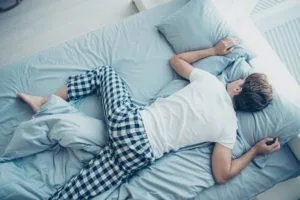Most adults blame a long day, a bad chair, or stress for their chronic back pain. But the truth is that one of the biggest culprits is something you do every night without thinking: your sleeping position. The way you arrange your body for 6–8 hours straight can help your spine recover or silently damage it.
Certain sleep habits can twist your spine out of its natural alignment and trigger morning stiffness, headaches, and long-term back issues. Understanding the worst sleeping positions is one of the most powerful back health upgrades you can make.
According to experts, the following sleeping positions are damaging your posture and possibly causing you chronic back pain.
Read Also: 10 Natural Ways to Sleep Better at Night (Without Pills or Melatonin)
1. Stomach Sleeping With One Knee Raised

Many people sleep in this position without realising the hidden strain it places on their spine. To some people, that is a more comfortable way of sleeping. Just because it is the most comfortable way for you doesn’t mean it is an ideal way to sleep.
When you lie on your stomach and lift one knee, your lower back rotates, your hips twist, and your neck is forced to stay turned for hours. Over time, this can lead to persistent low-back pain and stiff necks.
Fix it: Try transitioning to side or back sleeping. Place a pillow under your lower abdomen if you can’t give up stomach sleeping immediately.

2. Flat Stomach Sleeping

Even without the raised knee, stomach sleeping remains one of the worst sleeping positions for spinal alignment.
It flattens the natural curve of your lower back and overstretches the neck, contributing to chronic discomfort. The persistent pain you subject your neck and spine to eventually stays and develops into chronic back pain.
Fix it: Use a thin pillow or no pillow at all to minimise neck strain, or gradually shift to side sleeping with proper support.
Read Also: 10 Interesting Things That Happen to Your Body While You’re Asleep
3. Side Sleeping With the Top Leg Crossing Too Far Forward

Side sleeping can be healthy, but many people unknowingly do it wrong. When the top leg crosses forward onto the mattress, the pelvis rotates and twists the spine. This subtle misalignment can cause hip and lower-back pain.
Fix it: Place a pillow between your knees to keep the pelvis level. This is one of the easiest spine alignment tips that instantly improves comfort.
4. Back Sleeping Without Knee Support

Sleeping flat on your back isn’t automatically harmful, but without support under the knees, the lumbar spine may arch too much, especially for people with tight hip flexors. This can strain the lower back overnight.
Fix it: Place a small pillow or rolled towel under your knees to maintain your spine’s natural curve.
5. Side Sleeping With the Wrong Pillow Height

Even if your spine is aligned from the waist down, the wrong pillow height can ruin everything from the neck up. A pillow that is too high or too low pushes your head out of alignment with your spine, leading to neck pain, shoulder tension, and headaches.
Read Also: 7 Natural Teas to Help You Sleep Longer and Better at Night
The recommended pillow height varies by sleeping position, with side sleepers needing a high loft (5–7 inches), back sleepers a medium loft (4–6 inches), and stomach sleepers a low loft (2–4 inches) or no pillow. To determine the right height, aim for a pillow that keeps your spine neutral, ensuring your head and neck are in a straight, aligned position, taking into account your body type and mattress firmness.
Fix it: Choose a pillow that keeps your head level with your spine. When lying on your side, your nose should be in line with the centre of your chest.
The Key to Healthy Sleep Posture
Getting the most out of your sleep isn’t just about going to bed early and clocking in those 6 to 8 hours recommended sleep, but how you actually position yourself in the comfort of your bed determines if you benefit from your sleep or wake up to the dreaded waist pain that most adults suffer.
By adhering to this guide and avoiding these 5 Worst Sleeping Positions for Your Spine, your sleep quality and general well-being will significantly improve.



